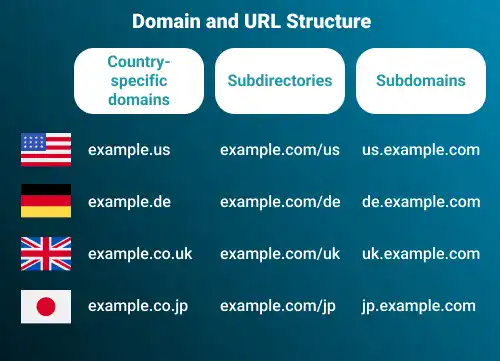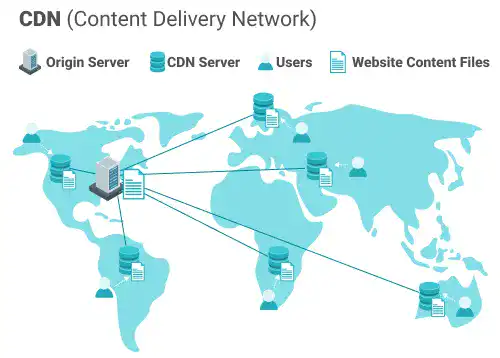International SEO Basics: Mastering SEO Across Borders

What is International SEO?
International SEO is about making your website friendly for people from different countries who speak different languages.
It helps search engines understand which countries you're targeting and which languages you use, allowing your site to appear in search results worldwide.
How to do International SEO?
International SEO requires additional approaches besides the standard SEO approaches. The following are the key considerations you need to explore for successful International SEO.
1. Country URL and Domain Structure Design
As you need to create localized content for each country, you need to prepare different URLs or domains to manage web pages for each country.
There are three major approaches:

Country-specific domains
This approach (e.g., example.uk, example.de) creates different websites for each country, like Amazon (amazon.co.uk, amazon.co.jp).
The advantage of this approach is that it sends a strong signal to users and search engines that separate websites target specific countries.
Subdirectories
This approach (e.g., example.com/uk/, example.com/de/) allows you to use the same website with different content for each country.
Many multinational corporations, such as Apple, Microsoft, Tesla, Nike, and others, use this approach.
This approach may be the most effective from the SEO point of view as it allows you to leverage domain authority.
Subdomains
This approach (e.g., uk.example.com, de.example.com) is a middle option between the two options above in terms of domain independence. It is less commonly used.
Site Structure and Internal Link Management
You need to design and manage the website structure and internal linking carefully as you need to manage a large number of pages in different languages.
For example, users should not suddenly jump to a page in a different language while they are browsing a website. To avoid this situation, you need to design the user flow carefully and add internal links properly.
2. Hreflang Tags Settings
Hreflang tags help search engines understand which language and regional version of a page to show in search results.
This prevents content duplication issues and improves search experience for users by directing them to the most relevant version of your content.
To implement Hreflang, you need to add the rel="alternate" and hreflang="country and language code" in the <link> tag while specifying the country URL in the head section of your webpage. You also need to set the canonical tag to tell search engines which URL is the main URL. Below is an example of Hreflang implementation.
Hreflang Tag Example
<head>
:
<link rel="canonical" href="https://www.apple.com/">
<link rel="alternate" href="https://www.apple.com/de/" hreflang="de-DE">
<link rel="alternate" href="https://www.apple.com/uk/" hreflang="en-GB">
<link rel="alternate" href="https://www.apple.com/jp/" hreflang="ja-JP">
:
</head>
This article gives detailed explanations of how to implement the hreflang tag – Hreflang: The Easy Guide for Beginners.
3. Keyword Research and Content Optimization by Country
Each market has its unique language nuances, search habits, and preferences.
Conducting local keyword research ensures that you use terms and phrases that your target audience in each country is searching for.
This increases the relevance of your content to local audiences and improves your visibility in search results.
Usually, keyword research tools such as Google Keyword Planner have country filtering.
You can apply the same approaches to keyword research and content optimization as your standard approaches, which will be explained in the next chapter.
4. Link Building by Target Market Segment
Each country or market has different communities and popular websites, so that relevant backlinks can differ by geography.
You'll need to customize your link-building efforts to maximize your exposure to the target audience for each geography.
For example, you may need to collaborate with local bloggers, industry leaders, and news outlets to get your content featured in each target country or market.
5. CDN implementation
If users across the world access a website hosted in a single location, there will be a latency issue that will slow down the page loading speed. This is not good from the SEO point of view as Google emphasizes page experience (Core Web Vitals) as a ranking factor.
CDN (Content Delivery Network) is a typical solution to avoid the latency issue. CDN uses a network of servers strategically located worldwide to cache (or store) copies of your website's content. When a user visits your site, the CDN delivers this content from the nearest server. This drastically reduces the distance the data travels, speeding up the loading time of your website. Essentially, caching your site's files on multiple servers allows for quicker access and a better user experience.

To use CDN, you can choose website or app hosting service providers, such as Firebase, Netlify, or Vercel. When you use those providers, they manage your content using their CDN. If you are using a hosting service without CDN, you can implement CDN, using CDN services, such as Cloudflare or Amazon CloudFront.
Conclusion of Chapter 6
In this chapter, we've covered the essentials of Geographical SEO, focusing on Local SEO to boost your visibility in nearby searches and International SEO to reach a global audience.
Local SEO helps you stand out in your community, while International SEO adjusts your content for different languages and countries. Both are key for tailoring your site to the right audience based on where they are searching from.
We've touched on important tools and strategies for each, from Google Business Profile for local listings to hreflang tags for international targeting. Although this is a high-level overview, it's a solid starting point for strategically targeting your desired audience based on location.




